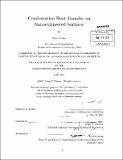Condensation heat transfer on nanoengineered surfaces
Author(s)
Paxson, Adam Taylor
DownloadFull printable version (8.456Mb)
Other Contributors
Massachusetts Institute of Technology. Dept. of Mechanical Engineering.
Advisor
Kripa K. Varanasi.
Terms of use
Metadata
Show full item recordAbstract
This thesis presents a series of three related studies with the aim of developing a surface that promotes robust dropwise condensation. Due to their remarkably low droplet adhesion, superhydrophobic surfaces were investigated for application to dropwise condensation. Although precise model superhydrophobic surfaces were necessary to gain insight into these phenomena, it was recognized that wide-scale implementation necessitates a surface that can be mass-produced at an industrial scale. To this end, anodized metal oxide surfaces were pursued as candidate condenser materials. First, a study was performed to determine the precise conditions leading to the transition between wetting and non-wetting states. By depositing pendant drops of various sizes on a superhydrophobic surface and observing their wetting behavior, a hitherto unknown mechanism for wetting transition is reported. A new phase diagram was developed which shows that both large and small droplet can transition to wetted states due to the new deceleration-driven and the previously-known Laplace mechanisms. It is shown that the attainment of a non-wetted superhydrophobic state is more restrictive than previously thought. Second, we investigate the large-scale fabrication of superhydrophobic surfaces via two different methods: solvent-induced crystallization of a thermoplastic polymer, and anodic oxidation of aluminum. Although the polymer surface as not able to withstand the high temperatures seen during condensation, the applicability of the anodized metal surface to dropwise condensation was further investigated. Third, to replicate the conditions of a typical power plant or desalination plant, an apparatus was constructed that condenses steam at pressures below 1 atm. It employs a vacuum chamber in which a surface is exposed to saturated steam at various pressures. The rig design and operating principles are explained, and the results of condensation tests on superhydrophobic anodized metal oxide surfaces are presented. It was found that although the metal oxide surfaces were able to resist wetting of macroscale droplets, they suffered from non-preferential nucleation and droplet growth. This led to the eventual growth of a macroscale Wenzel droplet, which proved to be difficult to shed from the surface.
Description
Thesis (S.M.)--Massachusetts Institute of Technology, Dept. of Mechanical Engineering, 2011. Cataloged from PDF version of thesis. Includes bibliographical references (p. 69-74).
Date issued
2011Department
Massachusetts Institute of Technology. Department of Mechanical EngineeringPublisher
Massachusetts Institute of Technology
Keywords
Mechanical Engineering.